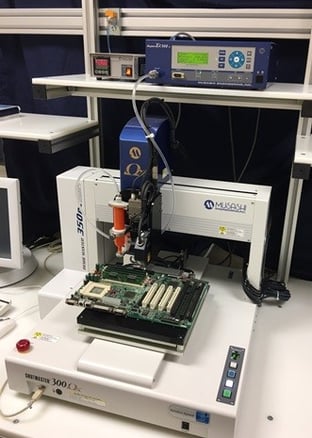
Whether you’re in a traditional manufacturing industry or on the cutting edge of pharmaceutical or biomedical research, your production line is likely to need at least one fluid dispensing system.
Choosing the right dispensing system can be difficult with such a wide range of equipment on the market, from high-speed systems that dispense adhesives and greases to precision-volume dispensers for chemicals.
We’ve written a series of posts on the advantages of different dispenser types, but here is a high-level overview:
Pneumatic Dispensers
The most widely used type of dispenser, pneumatic dispensers can be used for both line and dot dispensing.
Strengths
- precise application of thin lines and dots
- ease of operation
- low maintenance
- lower cost
Weaknesses
- cannot be used with fluids of especially high viscosity
- nozzle-to-product contamination possible
Common applications
- Smartphones and other electronic production
Learn more about pneumatic dispensers.
Non-contact Jet Dispensers
This is a relatively new type of dispenser which jets fluids from a small distance so that the nozzle does not contact the surface of the product.
Strengths
- ideal for uneven surfaces
- eliminates the risk of nozzle contamination
Weaknesses
- less precise application
- typically higher cycle times (with some notable exceptions)
Common applications
- underfill for circuit boards
- biomedical and pharmaceutical applications
Learn more about non-contact jet dispensers.
Mechanical Positive Displacement Dispensers
Mechanical dispensing systems use a rod or piston to physically force a fluid from the chamber.
Strengths
- ideal for fluids with fluctuating viscosities
- consistent and accurate volume control
Weaknesses
- higher maintenance
- higher cost
Common applications
- LED assembly
Learn more about mechanical displacement dispensers.
Other Dispenser Systems
There are many other types of dispensers available as well:
- Small dosage dispensers are special systems used to meter our extremely small volumes of materials, down to the nanoliter level. They are most often found in the pharmaceutical and biomedical field, as well as electronics requiring extremely small components.
- Spraying or coating dispensers are used to spray liquids or apply coatings to large areas.
- Tubing dispensers are best suited for low viscosity fluids.
When to call an expert...
We hope this overview has been useful in helping you narrow down which type of dispenser you should be using. To find exactly which model will offer you the best value for your production line, talk to the engineers at Izumi International, who are experts in the fluid dispensing field.
Want to see exactly how the dispenser will perform before making a decision? We have a dispensing laboratory in Greenville, SC, where we can test your application and show you the results. Call us at 864.288.8001 for a consultation, or request an estimate online by clicking the banner below.


